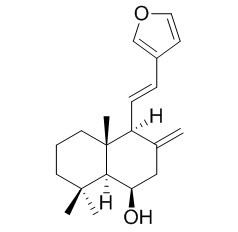Yunnancoronarin A
Yunnancoronarin A shows cytotoxicity against the lung adenocarcinoma cells A549 and leukemia cells K562, with the IC(50) value of 2.20 microM.
Inquire / Order:
manager@chemfaces.com
Technical Inquiries:
service@chemfaces.com
Tel:
+86-27-84237783
Fax:
+86-27-84254680
Address:
1 Building, No. 83, CheCheng Rd., Wuhan Economic and Technological Development Zone, Wuhan, Hubei 430056, PRC
Providing storage is as stated on the product vial and the vial is kept tightly sealed, the product can be stored for up to
24 months(2-8C).
Wherever possible, you should prepare and use solutions on the same day. However, if you need to make up stock solutions in advance, we recommend that you store the solution as aliquots in tightly sealed vials at -20C. Generally, these will be useable for up to two weeks. Before use, and prior to opening the vial we recommend that you allow your product to equilibrate to room temperature for at least 1 hour.
Need more advice on solubility, usage and handling? Please email to: service@chemfaces.com
The packaging of the product may have turned upside down during transportation, resulting in the natural compounds adhering to the neck or cap of the vial. take the vial out of its packaging and gently shake to let the compounds fall to the bottom of the vial. for liquid products, centrifuge at 200-500 RPM to gather the liquid at the bottom of the vial. try to avoid loss or contamination during handling.
Biomed Pharmacother.2024, 173:116319.
Nutrients2023, 15(18), 4016.
Int J Mol Sci.2024, 25(17):9673.
Food Chem.2020, 313:126079
J Pharm Biomed Anal.2019, 164:119-127
Food Chem.2020, 332:127412
J Ethnopharmacol.2017, 198:91-97
J Nat Prod.2022, doi: 10.1021
J. ISSAAS2023, 29(2):36-51.
Purinergic Signal.2024, doi: 10.1007.
Related and Featured Products
Phytother Res. 2010 Jul;24(7):1009-13.
Labdane-type diterpenes from Hedychium gardnerianum with potent cytotoxicity against human small cell lung cancer cells.[Pubmed:
19960422]
METHODS AND RESULTS:
Seven labdane-type diterpenes, coronarin E, coronarin A, Yunnancoronarin A, yunnancoronarin B, hedyforrestin B, villosin, and hedyforrestin C were isolated from the rhizome of Hedychium gardnerianum and evaluated for cytotoxic activity against human small cell lung cancer (NCI-H187) and non-cancerous Vero cells. The results showed that villosin exhibited potent cytotoxic activity with IC(50) of 0.40 microM, which was higher than that of the drug ellipticine (IC(50) 1.79 microM). Moreover, ellipticine was very toxic to Vero cells (IC(50) 7.47 microM) whereas the toxicity of villosin was undetectable at concentration lower than 166.42 microM.
CONCLUSIONS:
The results have indicated that the lactone ring is essential for high cytotoxic activity and that the presence of a hydroxyl group at the 6 or 7 position causes decrease in activity. The very high cytotoxicity against the NCI-H187 cells and the exceptionally high selectivity index (>416) of villosin suggested that this compound may be used as a potential lead molecule for antitumor therapeutic development.
Chem Pharm Bull (Tokyo). 2008 Feb;56(2):210-2.
Cytotoxicity of labdane-type diterpenoids from Hedychium forrestii.[Pubmed:
18239312]
Two new labdane-type diterpenoids, hedyforrestin D (1) and 15-ethoxy-hedyforrestin D (2), and three known compounds, Yunnancoronarin A (4), B (3) and C (5) were isolated from the rhizomes of Hedychium forrestii.
METHODS AND RESULTS:
The structure of the new diterpenoids was established as 6beta,15xi-dihydroxylabda-8(17),11,13-trien-15,16-olide (1), and 6beta-hydroxy-15xi-ethoxylabda-8(17),11,13-trien-15,16-olide (2) on the basis of spectroscopic analyses. In addition, the isolated compounds were evaluated for their cytotoxicity against the lung adenocarcinoma cells A549 and leukemia cells K562 through 3-[4,5-dimethylthiazol-2-yl]-2,5-diphenyltetrazolium bromide (MTT) assays. Of these, compounds 3 and 4 exhibited the most activity with IC(50) values of 0.92 and 2.20 microM, respectively, whereas 5 was inactive against A549 cells and 1 was inactive against both cell lines up to a concentration of 300.81 microM.
CONCLUSIONS:
This shows that both the hydroxy substitution and orientation of unsaturated lactone group in the five-membered ring of C-13 to C-16 seem to play an important role in the anti-tumor activities of human lung adenocarcinoma and leukemia.
Zhongguo Zhong Yao Za Zhi. 2009 Jan;34(2):180-2.
[Studies on chemical constituents from rhizomes of Hedychium chrysoleucum].[Pubmed:
19385181]
To investigate the chemical constituents from the rhizome o fHedychium chrysoleucum.
METHODS AND RESULTS:
The compounds were isolated by column chromatography on silica gel. The structures were identified by NMR, IR and MS analyses. Seven compounds were isolated and identified as hedychenone (1), coronarin A (2), Yunnancoronarin A (3), coronarin E (4), beta-sitosterol (5), cryptomeridiol (6), and beta-eudesmol (7).
CONCLUSIONS:
Compounds 1-7 were obtained from this plant for the first time.



